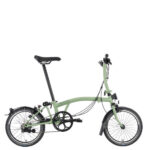The Lectric XP 2.0 electric bike has garnered significant attention in the world of personal transportation, particularly for those seeking a blend of convenience and power for their daily commutes. This review delves into the experiences of a user who adopted the Lectric XP 2.0 as their primary commuting solution, offering insights into its features, performance, and suitability for urban environments.
Initial Impressions and Component Analysis
Upon unboxing, the Lectric XP 2.0 presents itself as a robust and well-designed machine. The battery, a crucial component of any electric bike, required approximately 3 hours for a full charge right out of the box. The tires are CST Patrol 20×3.0, inflated to 30 PSI, and appear to be standard fat knobby tires, suitable for a variety of urban terrains. They are delivered with a minimal amount of air, necessitating inflation before the first ride.
The standard seat, branded Lectric and manufactured by Chaunts, measures roughly 11 inches long by 8 inches wide. While functional, its comfort level is only moderate. It bears resemblance to models available on online marketplaces, suggesting a focus on practicality over premium comfort in the base model. For riders prioritizing comfort, an immediate upgrade might be considered.
The handlebars are straight, measuring 25 inches from tip to tip, with a slight U-bend in the central section. They feature a common 1″ / 25.4mm diameter at the center, and the handlebar clamp’s two-bolt design simplifies potential replacements. The reviewer noted a preference for handlebars with more backsweep to facilitate a more upright riding posture, indicating a degree of customization available to riders.
A notable design flaw highlighted is the placement of the battery key. Positioned directly above the main cables leading to the bike’s rear, key insertion is described as cumbersome. Despite this ergonomic quirk, the overall initial aesthetic of the bike is positive.
First Commute and Performance Insights
Setting tire pressure to 28 PSI, the reviewer embarked on an initial test commute, simulating a typical weekday ride to work. The route encompassed busy city streets, crowded bike paths, and significant inclines, providing a comprehensive assessment of the bike’s urban commuting capabilities.
The standard seat’s moderate comfort level was confirmed during the ride, prompting an immediate decision to upgrade. A Cloud 9 seat and Satori seat post were ordered to enhance riding comfort for future commutes. The pedals also received criticism for insufficient grip, with an incident of a pedal folding up mid-ride, almost causing a fall. This led to a swift decision to replace them with traditional, non-folding pedals for improved safety and control.
Conversely, the brakes were praised for their exceptional performance, proving their effectiveness in a sudden stop situation caused by a car pulling out unexpectedly. A minor rubbing noise from the brakes was noted for further investigation.
The reviewer’s commuting strategy involved leveraging the electric assist for the uphill return journey, aiming for a less strenuous ride to work. However, the inclines proved more challenging than anticipated, leading to reliance on the bike’s electric capabilities for the majority of the uphill sections.
The pedal assist system (PAS) was primarily used, predominantly at levels 1 or 2, with occasional throttle engagement. The PAS experience was likened to driving a turbocharged older vehicle, with a noticeable surge of power engagement. However, the PAS was found to be less than ideal in stop-and-go urban traffic, often requiring disengagement (setting to PAS level 0) to prevent unintended acceleration in pedestrian-heavy zones like crosswalks.
Speed during the commute was capped at 20 MPH, with averages closer to 15 MPH for much of the journey. A combination of second gear and PAS level 2 was effective for less congested stretches, while first gear with PAS level 1 or 0 was preferred for crowded and stop-start conditions. Battery voltage decreased from 54V to 50V over the approximately 6-mile commute. The bike’s compact size allowed it to fit within available bike lockers at the workplace, a significant advantage for security and weather protection.
Long-Term Commuting and Practical Considerations
Continuing to commute on the Lectric XP 2.0, the reviewer accumulated over 50 miles, reinforcing its viability as a daily commuter. The upgraded Cloud 9 seat and Satori seat post proved to be worthwhile investments, significantly improving ride comfort. Similarly, the replacement of folding pedals with durable, non-folding nylon pedals enhanced grip and rider confidence.
Navigating urban environments, particularly starting from curbs in traffic, required an adjustment period. Lower gears and PAS levels (0 or 1) were necessary for initial stability, as the smaller, heavier wheels of the electric bike felt less stable at very low speeds compared to traditional bicycles. Quick acceleration, either through pedaling, PAS, or throttle, was key to achieving stable handling. In dense traffic, dismounting and walking the bike was sometimes the most practical approach. Once in motion, the bike exhibited predictable and easy handling.
Battery range was observed to be around 20 miles per charge, with recharges typically initiated when voltage dropped below 43V. This range was considered satisfactory given the reviewer’s weight and frequent use of PAS levels 1 and 2 on hilly terrain.
A crucial realization emerged regarding the Lectric XP 2.0’s suitability for extended, unplanned rides. While pedaling without power is possible, it is not practical for significant distances, especially uphill, due to the bike’s weight. This prompted the development of an emergency plan for situations involving battery depletion or mechanical failure far from home. The plan involves securing the bike in a safe, visible location, removing the battery, locking the bike, and arranging for vehicle retrieval, rather than attempting to pedal the heavy bike over long distances.
Conclusion: A Commuting Solution with Considerations
Overall, the Lectric XP 2.0 electric bike proved to be a capable and enjoyable commuting solution. Its ability to conquer hills and navigate urban environments effectively is a significant advantage. While some components like the seat and pedals may warrant upgrades for enhanced comfort and safety, the core functionality and performance of the bike are commendable. Potential buyers should consider the battery range for their commute distance and be mindful of the bike’s weight when considering unpowered riding scenarios. For those seeking an affordable and powerful entry into the world of Lectric Electric Bikes for commuting, the Lectric XP 2.0 is a strong contender, offering a blend of practicality and electric-assisted ease.


